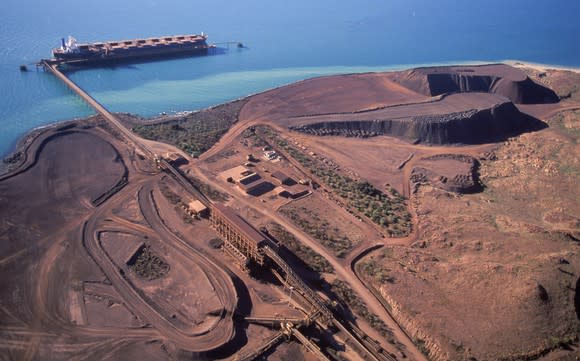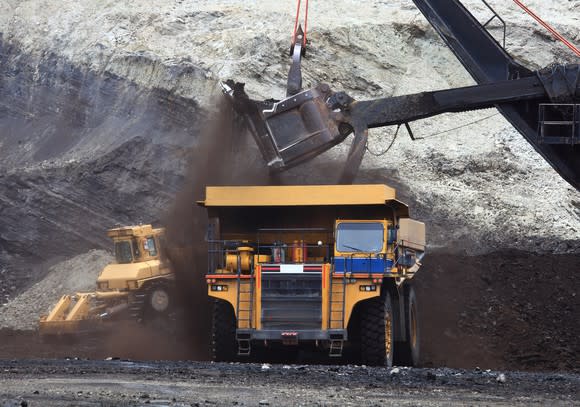Top Stocks in Mining
Mining is a business that is essential to building a modern society but is one that doesn't get much attention aside from bad press. Mining supplies the essential commodities we need to build just about everything from roads to smartphones. That essential need for metals and other extracted minerals means that it is a business that is likely going to last for decades and produce long-term returns despite the boom and bust nature of the business.
Even though the market for global commodities is a complex one, there are a few characteristics that make a mining stock a lucrative one for investors. So let's take a look at some of the top mining stocks out there and a few things investors should look for when picking an investment in this industry.

Image source: Getty Images.
And the contestants are...
For investors, there are two distinct categories of mining companies: The diversified giants and the specialists. Each has their benefits and drawbacks as investments, which we'll get into below.
Here is a list containing some of the largest diversified mining companies in the world and a few select specialists that are listed on the American exchanges. I excluded gold and silver miners from this list because there are so many that they deserve their own list. One of the hottest topics in the mining industry is electric vehicles and the minerals needed to make batteries, so I was sure to add companies that had any exposure to the big three metals associated with batteries today: Lithium, Cobalt, and Nickel.
Company | Market Capitalization | Minerals extracted | Return on equity (5-year mean) | Dividend Yield (%) |
|---|---|---|---|---|
Anglo American (NASDAQOTH: AAUKF) | $33.8 billion | Diamonds, Copper, Platinum, Metallurgical coal, Iron ore, Nickel, Ferroalloys, Cobalt | -6.2% | 2% |
Alcoa Corporation (NYSE: AA) | $10.4 billion | Aluminium | -- | N/A |
Albermarle (NYSE: ALB) | $14.9 billion | Lithium | 15.5% | 0.96% |
BHP Billiton (NYSE: BHP) | $131.7 billion | Copper, Iron ore, Metallurgical coal, Nickel, Zinc, Potash, and Oil | 7.8% | 2.2% |
Cameco Corporation (NYSE: CCJ) | $3.83 billion | Uranium | 2.3% | 3.2% |
Cleveland-Cliffs (NYSE: CLF) | $2.4 billion | Iron ore | 6.6% | N/A |
Freeport-McMoRan (NYSE: FCX) | $28.2 billion | Copper, Gold, and Molybdenum | -29.3% | N/A |
Glencore (NASDAQOTH: GLNCY) | $79.4 billion | Copper, Zinc, Lead, Nickel, Iron ore, Ferroalloys, Aluminium, Coal, Oil, and Cobalt | -4.2% | 1.3% |
Rio Tinto (NYSE: RIO) | $101 billion | Aluminium, Iron ore, Copper, Diamonds, Uranium, Metallurgical coal, Titanium, and Salt | 4.7% | 4.1% |
Sociedad Quimica y Minera de Chile (NYSE: SQM) | $16.4 billion | Lithium | 15.6% | 2.2% |
Southern Copper (NYSE: SCCO) | $38.4 billion | Copper, Molybdenum, Zinc, Lead, Coal and Silver | 22.2% | 1.2% |
Teck Resources (NYSE: TECK) | $17.2 billion | Copper, Metallurgical coal, Zinc, and Oil | 1.6% | 0.5% |
Vale SA (NYSE: VALE) | $69.1 billion | Iron ore, Nickel, Metallurgical coal, Copper, Cobalt, and Ferroalloys | -6.1% | 3.1% |
Source: Ycharts and company releases.
Here's the challenge for any investor in this industry. All mined minerals are commodity products. That means this industry's prospects are prone to booms and busts. While no one can precisely time the market to buy at the bottom or sell at the top, you're more likely to generate decent returns in the long run when you buy companies in this industry when the news is all doom and gloom, and to avoid the temptation of buying when everyone is euphoric.
It doesn't matter whether a mining company is a diversified giant like BHP Billiton or a small specialist like Cameco. There are a few characteristics that all mining companies need to do well to succeed over the long term.
Low-cost operations
Financial discipline
A long-term view of capital allocation
If companies can do these three things effectively, they will be able to ride out the tough times in the industry and be well positioned to make good returns when the boom times come. Management teams that get impatient when commodity prices are high tend to overspend on expensive projects that typically take decades to generate a decent return. If you need examples of what happens when companies don't do these three things well, look at Freeport McMoRan's entry into the oil business and Cleveland-Cliffs' iron ore investments in 2011.
Beyond these three things, there are some special considerations investors should make depending on whether an investor is interested in a diversified miner or a specialist.

Image source: Getty Images.
Diversified mining: All eyes on Asia
The primary minerals for just about every mining company are all deeply tied to the construction industry. Iron ore, ferroalloys, metallurgical coal, zinc, and nickel are all critical components for making steel, while copper and lead are critical elements for constriction and electronics. That's the deceiving part about a diversified miner. Typically a company that has fingers in so many different pies would be able to offset weakness in one segment by the strength of another. However, since so many of these elements are inextricably linked to each other by their end users, they don't really behave independently of one another.
Since all of these elements play a significant role in construction, their fates are deeply tied to the economies in Asia, specifically China. Today, Asian countries consume more than two-thirds of the worlds steel, nickel, copper, aluminum, lead, and zinc. By contrast, all of North America consumes around 10% of these respective minerals. So even if we were to see incredible construction in North America but the Asian market was struggling, then chances are global consumption would be weak.
While we are likely going to see demand for these materials ebb and flow over time, they will continue to be must-have commodities for economic development. So as an investor, your job is to sniff out the ones that will most likely execute on those three things above. Here's a quick glimpse at how those diversified companies have performed related to these metrics.
Company | EBITDA Margin (trailing 12 months) | Return on Capital Invested (5-year median) | Financial debt to EBITDA |
|---|---|---|---|
Anglo American | 35% | -3.24% | 1.69 |
BHP Billiton | 49.8% | 7.31% | 1.74 |
Freeport McMoRan | 30% | 1.71% | 3.41 |
Glencore | 5.5% | 0.80% | 3.33 |
Rio Tinto | 38.9% | 4.23% | 1.26 |
Southern Copper | 46.8% | 12.42% | 2.06 |
Teck Resources | 44.3% | 2.59% | 1.33 |
Vale | 41.9% | 0.63% | 2.08 |
Data source: Ycharts. Chart by author.
Based on this chart, it would seem that the three best performers in this industry are Southern Copper, BHP Billiton, and Rio Tinto. All three have high margins, have been able to generate fairly decent returns over the past five years (which have been terrible years for mining, for what it's worth), and have earnings power to support their balance sheets.
Specialty mining: What's the advantage?
Smaller mining companies have to do all of the things that diversified miners do. The trouble is that as specialists, they don't have the economies of scale that their larger peers have. So the only way for a specialty miner to be successful is they have to have one distinct advantage that makes it close to impossible for the larger miners to compete in that particular market.
A great example of this is Cleveland-Cliffs. Even though the company only produces iron ore, it has a slight competitive advantage compared to the mining giants because of geography. One of the most significant costs of iron ore is transportation, which gives U.S.-based iron ore a considerable price advantage over imported iron ore. Cleveland-Cliffs mines represent 55% of all U.S. iron ore production, so it has a considerable share in a price-advantaged market. Prior management teams have squandered that advantage in the past, but the current management team is much more focused on getting the most out of its American assets.
Another example is Sociedad Quimica y Minera de Chile (SQM). It too has an immense geographic advantage. Lithium isn't really mined in the traditional sense. Rather, it is a product found in briny waters. Those waters are then pumped into massive evaporation ponds to leave only the water's mineral content behind. SQM just happens to have 1,700 acres of land in one of the driest deserts in the world that also is sitting on a supply of briny water with high concentrations of lithium in it. With nature on its side, SQMs operations are extremely hard to replicate.
Company | EBITDA margin (trailing 12-months) | Return on invested capital (5-year median) | Financial debt to EBITDA |
|---|---|---|---|
Alcoa | 15.3% | -- | 0.85 |
Albemarle | 23.5% | 10.1% | 3.72 |
Cameco | 4.5% | 2.2% | 15.54 |
Cleveland-Cliffs | 22.2% | -3.5% | 3.38 |
Sociedad Quimica y Minera de Chile | 29.2% | 11.1% | 1.20 |
Source: Ycharts
SQM stands head and shoulders above the other specialty miners as a viable investment. It has that great competitive advantage and the best financial metrics of the bunch. On top of that, it has a hand in one of the hottest mining commodities today. No wonder it trades at such a premium today.
What a Fool believes
Mining can be a lucrative business, but it can also be an endless money pit if you don't do your homework. All too often, investors try to invest in mining trends thinking the value of that particular commodity can go nowhere but up (anyone remembers rare earth minerals? Anyone? Bueller?). That is hardly ever the case, though, because the laws of supply and demand will eventually catch up.
Investing in mining might be a good place to put your money. We are in a phase of global economic growth that is likely going to lead to greater demand for commodities. Also, it appears that most of these companies have learned their lesson about capital allocation after the Chinese commodity bubble at the beginning of the decade. If we continue to see modest increases in demand and prices coupled with prudent capital spending, then there are certainly a few mining companies on these lists that could be top picks for your portfolio.
More From The Motley Fool
Tyler Crowe owns shares of BHP Billiton and Cleveland-Cliffs. The Motley Fool has no position in any of the stocks mentioned. The Motley Fool has a disclosure policy.

 Yahoo Finance
Yahoo Finance 